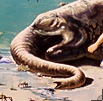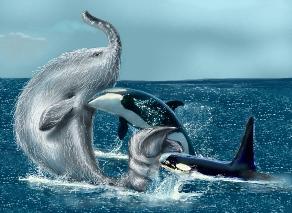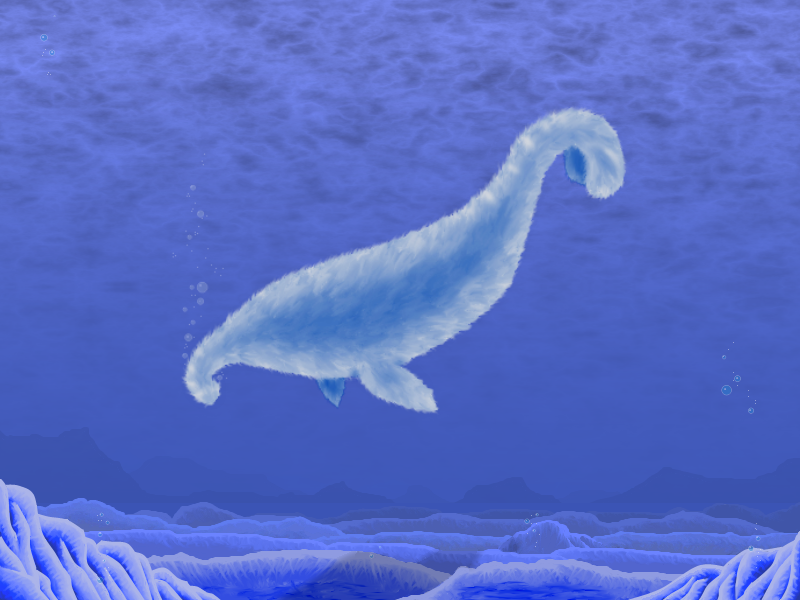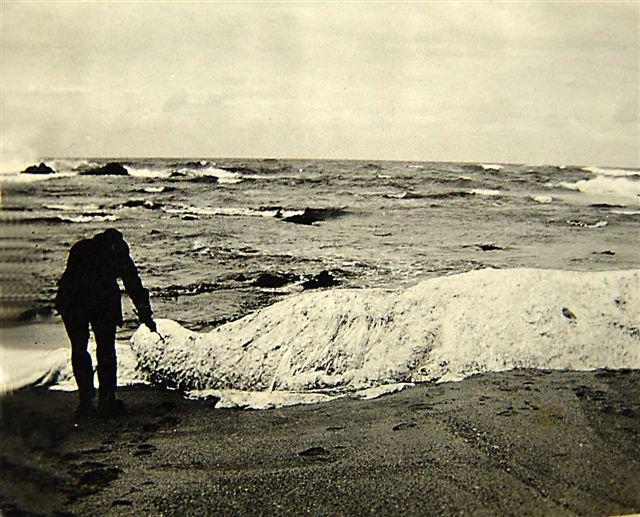Trunko: Imagined, Imaged, and Investigated
Posted by: Loren Coleman on September 7th, 2010

Alexis Rockman’s head detail of Trunko, from “Map of Cryptozoology.”
Has the mystery of Trunko been solved? Karl Shuker certainly feels with the discovery of a photograph of the mysterious carcass, part of the solution is closer to being affirmed.

First, let me share some Trunko basics, background, and visuals.
Trunko is Karl Shuker’s name for an animal allegedly sighted at Margate, South Africa, on October 25, 1924, according to an article entitled “Fish Like A Polar Bear,” published in the December 27, 1924, edition of London’s Daily Mail.
The animal was reportedly first seen off the coast battling two killer whales or orcas, which fought the unusual creature for three hours. It used its tail to attack the whales and was said to have lifted itself out of the water by about 20 feet. One of the witnesses, Hugh Ballance, described the animal as looking like a “giant polar bear,” during a final fight.

Artist Bill Asmussen’s depiction of Trunko being mauled by orcas. Credit: Book of Thoth.
The creature then washed ashore on Margate Beach but despite being there for 10 days, no scientist ever investigated the carcass while it was beached. No reliable description has been published, and no photographs of it have ever been published, until now. Various descriptions talked of its snowy-white fur, an elephantine trunk, a lobster-like tail, and a carcass devoid of blood.
The animal was said to be 47 feet long, 10 feet wide, and 5 feet high, with the head said to have been replaced, actually, by a trunk that was 5 feet long and 14 inches in diameter. That’s why this was coined “Trunko,” by cryptozoologist Karl Shuker. The tail reportedly was 10 feet, and the fur was 8 inches long.
The creature’s corpse spent 10 days on the Margate beach, until the sea finally reclaimed the carcass.
In the March 27, 1925 edition of the Charleroi Mail, in Charleroi, Pennsylvania, an article entitled “Whales Slain By Hairy Monster” reported that the whales in the Margate incident were killed by a strange creature which was washed up on a beach exhausted and fell unconscious, but made its way back into the ocean and swam away after 10 days. (That seems rather fanciful and full of added journalistic fiction.)


Two images of Trunko above are the Kryptid’s Keep art by Lance Bradshaw.

Alexis Rockman’s extended detail of Trunko, from “Map of Cryptozoology.”
Now, have cryptozoologists Karl Shuker and Markus Hemmler solved this old mystery?

Karl writes in his blog: “German correspondent Markus Hemmler emailed me with some remarkable news. He had discovered a website containing an allegedly genuine photograph of Trunko – a monicker, incidentally, that I had somewhat lightheartedly given to Margate’s mystery sea monster in my book The Unexplained (1996) but which, to my great surprise, has since become its accepted name. Moreover, the photograph had been snapped by none other than Mr A.C. Jones of Johannesburg – the correspondent and photographer for an article on this entity that had been published in the Rand Daily Mail and also in Wide World Magazine way back in July 1925, thus providing a promising air of authenticity to the image.”
Karl Shuker’s reconfirms his early findings of what he thinks this is, the carcass of a decaying whale, due to this photograph. Karl notes: “The appearance of Trunko’s remains in this photograph reaffirms my opinion – first presented in my book Extraordinary Animals Revisited (CFZ Press: Bideford, 2007)…that it was a globster, not a bona fide cryptid.”
Globster, giant octopus, decaying whale. The level of interactive explanations can be confusing.
Also, there are the points to be considered about that reported white fur, seen before the animal was dead, when it was fighting with the killer whales.
Karl picks up from discussions by Lance Bradshaw at his Kryptid’s Keep website, referenced above, this, “If Ballance’s testimony is to be believed, Trunko bore its snowy fur while it was still very much alive, battling the whales. If this is true, then clearly its fur cannot be explained away as exposed connective fibres. Moreover, it also suggests that Trunko was mammalian, albeit wholly unlike any mammal previously recorded by science.”
What was Trunko, after all?
Karl’s detailed examination can be found here.
About Loren Coleman
Loren Coleman is one of the world’s leading cryptozoologists, some say “the” leading living cryptozoologist. Certainly, he is acknowledged as the current living American researcher and writer who has most popularized cryptozoology in the late 20th and early 21st centuries.
Starting his fieldwork and investigations in 1960, after traveling and trekking extensively in pursuit of cryptozoological mysteries, Coleman began writing to share his experiences in 1969. An honorary member of Ivan T. Sanderson’s Society for the Investigation of the Unexplained in the 1970s, Coleman has been bestowed with similar honorary memberships of the North Idaho College Cryptozoology Club in 1983, and in subsequent years, that of the British Columbia Scientific Cryptozoology Club, CryptoSafari International, and other international organizations. He was also a Life Member and Benefactor of the International Society of Cryptozoology (now-defunct).
Loren Coleman’s daily blog, as a member of the Cryptomundo Team, served as an ongoing avenue of communication for the ever-growing body of cryptozoo news from 2005 through 2013. He returned as an infrequent contributor beginning Halloween week of 2015.
Coleman is the founder in 2003, and current director of the International Cryptozoology Museum in Portland, Maine.










Keep in mind that one “eyewitness” claimed (after the fact) to have seen several “Montauk Monsters” lurking on the beach where the decaying waterlogged raccoon was later found. And some kids claimed to have beaten the bloated dead sloth known as the “Panama Creature” even though it would have been dead at the time. So the white “fur” could easily have appeared only after the creature’s decomposition, even if eyewitnesses reported seeing it beforehand.
Bradshaw wrotes: “The stark set of contradictions present in […] two separate news articles proves one thing: information can become altered over time, either intentionally or accidentally. With that being said, how can we know which parts of the accounts are accurate, and which parts are the result of rumor?” Therefore I would be very interested (and I’am sure also all other cryptozoologists) in obtaining the article of the London Daily Mail from 27 December 1925 or any other source available (maybe there’s an south-african article of 1922?).
From what distance? Did the witnesses carry binoculars?
The likeliest explanation is that the orcas were not “fighting” an unknown cryptid, but instead were having a feast with a bloated whale carcass which might have seen to have volition of its own due to the killer whales’ frenzy. But I admit this theory does not explain how the carcass could lift itself 20 feet off the water —unless that part is a subsequent added embellishment.
Something of a late addendum, BUT… last night for some inexplicable reason I remembered the news of some years ago, about a new species of lobster that bears a bizarre coat of “fur” around its pincers.
[This is the so-called “Yeti lobster.”]
I think it might be pertinent to bring this up; not only because Trunko’s tail was allegedly like a lobster’s, but also because it does show some non-mammalian can display something very similar to a fur coat.
You have exactly one named witness telling a fantastical story. I don’t see a reason to think other than that a globster came ashore and Mr. Ballance (who might in fact have seen whales lunging at the carcass while it was in the water) couldn’t resist embellishing the story. (If not for the photos, I would have thought the whole thing a journalistic hoax.)
I agree but naturally I want more informations to proof the details… I was happy to find the article of Mr. Jones in the Wide World Magazine and Karl has written a new article about this: Trunko: Two more photographs. So if you assume that what Mr. Jones tells – especially if the timeline is true – then we have two incidents mixed into one and spiced up with some fantastic pieces for example an lobster-like tail. It is not sure after his description if the second animal beside the whale was an unknown animal at all, if it was alive or not or if it was white-furred in this incident. This story was doubtful before and I think this hardend after our new research. Before I found the first picture I’ve also thought that Balance or a journalist has done an Hoax. As no author as far as I know has written anything about the background of Balance I wanted to check this out and actual I found a motivation for an Hoax.
“Like several towns along KwaZulu-Natal’s South Coast, Margate took its name from the original farm bought there in 1919 by a Mr. Hugh Balance. Paying the princely sum of £466 he chose it, he said, for “its beautiful beach and congenial scenery” – hardly sound agricultural reasons. However farming was not to be its destiny: in 1921 Balance decided to subdivide the farm into half-acre plots and form a township […]. Due to the areas extreme isolation initial sales were sluggish, but then something remarkable happened to turn both Balance’s and Margate’s fortunes around. During the winter of 1922 a strange occurrence took place off what is now Margate Beach. So strange it received worldwide headlines and put Balance’s new township firmly on the map.” Source: http://www.margateholidayfun.co.za/MARGATE-HISTORY.php
An happy incident for Balance to watch and find “Trunko” at this time or not? Anyway that now we have three pictures and so not the whole story is an hoax it means not that such a motivation has not played a part in the whole story.
Have faith Trunko believers! ( Awkward Salute )